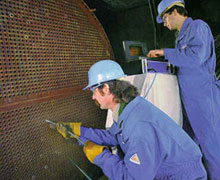Eddy Current Testing (ET)

ET instruments can be small and portable, or large multi-channel devices. The method is used only on electrically conductive materials, both ferrous and non-ferrous. But since so many other easier techniques are available for ferrous materials, such as MT, ET finds its application more suited to non-ferrous materials.
An energized electric coil induces a magnetic field into the tested specimen. The fluctuating magnetic field generates an electric eddy current. The presence of a flaw increases the resistance to the flow of eddy currents. This change is electronically analyzed to provide flaw severity or material condition information.
COURSE CONTENT (Modified as per client’s job needs):
Introduction to Eddy Current Testing, Electricity and magnetism, Voltage / current / inductance, Impedance, Impedance diagrams, Eddy current and its characteristics, Eddy current variables, ET systems and their selection criteria, General applications, Reference standards, Tubing inspection, Testing techniques, ET variables: Conductivity, Corners, Depth of penetration : Standard depth of penetration / Effective depth of penetration, Discontinuities, Edges, Electromagnetic coupling, Fill factor, Frequency, Geometry, Lift-off and Fill factor, Material thickness and composition, Radii, Permeability, Temperature; IACS conductivity standard, Effect of inspection conditions on ET, Eddy current intensity distribution, Eddy current test variables.
Practical’s
ET instruments and their salient features, Test item and test set up, use of standard test blocks for calibration, sensitivity setting, detecting/ judging/sizing/locating flaws on specimens with known flaws; Reporting.
|